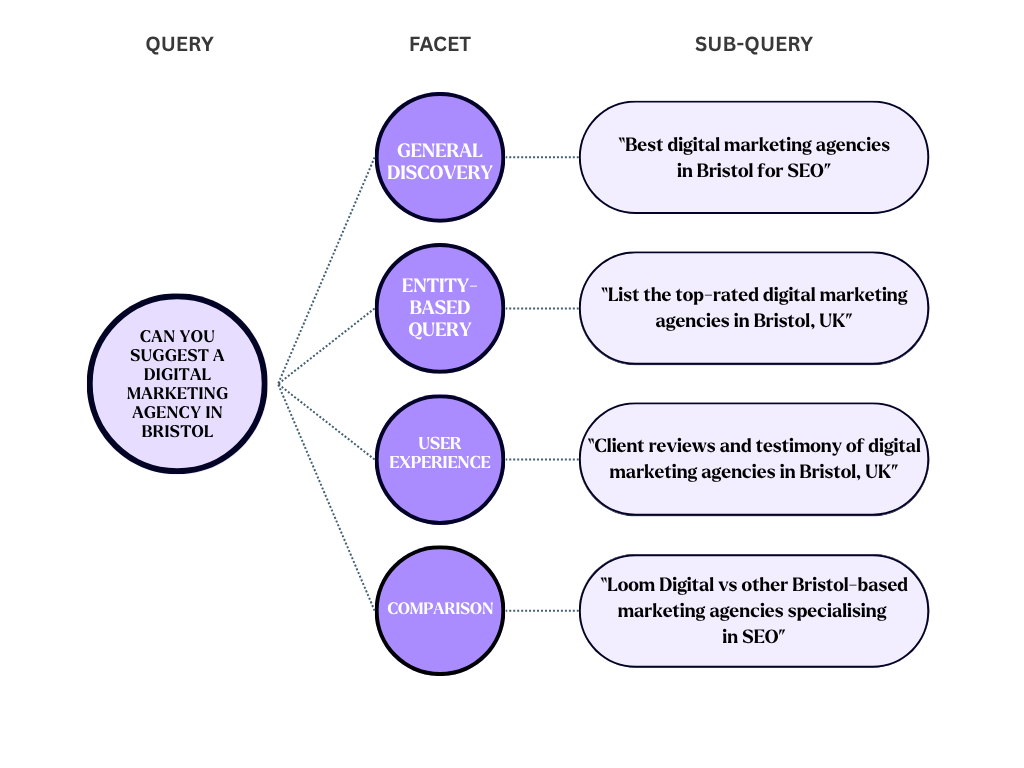The recent launch of Google’s AI Mode could represent the biggest step in what’s been a notable shift in user search behaviour since the mass adoption of AI features and tools. Although it’s still in its early stages, this expansion on AI Overviews is already prompting serious questions about the future of search, and has the potential to radically alter how we research information and interact with content.
We’re taking immediate steps to understand how AI Mode works, what it means for our paid and organic strategies and how we can evolve our approach to ensure our clients retain visibility. AI has radically shaken up digital marketing, and we’re committed to understanding what it values and prioritises. Having explored AI Mode in its testing phase, here’s how we’re making changes in preparation for its full implementation.
Google AI Mode: Everything we know so far
After initial US testing, AI Mode launched in the UK in 2025. As Google have stated “AI Mode is a new, intuitive way to address your most complex, multi-part questions and follow-ups, and satisfy your curiosity in a richer way. Using a custom version of our latest Gemini 2.5 model, it lets you ask nuanced questions that would have previously required multiple searches.”
Through initial research and experimentation using prompts to analyse search results, here’s what we’ve learned about AI Mode so far:
Expanded search options and follow-up questions
AI Mode encourages a more conversational way of searching. Something that resembles how many users have adopted LLMs such as ChatGPT as a search engine.
Rather than ending a session with one query, users are prompted to continue exploring with suggested follow-up questions. This keeps users engaged for longer and opens up more opportunities for brands to appear across multiple touchpoints within a single Google AI search journey. While a page might not be relevant for the initial query, it may be possible to optimise it for follow up questions.
This means results are more comprehensive and nuanced, but also that your content needs to address topics in a more holistic and structured way to be picked up as part of these broader answer sets.
Linking to web sources
Despite providing direct answers, AI Mode still displays links to the websites it pulls information from. These links are positioned as citations, offering users the option to dig deeper.
While visibility in these results may look different from traditional blue links, there’s still an opportunity for brands to earn presence by creating clear, high-quality content that’s easy for Google to summarise and reference. Alternatively, authors can add AI-friendly summaries at the end of their content.
Providing additional context
AI Mode can personalise results by factoring in a user’s previous searches, location, preferences, and even their activity across other Google products. This level of additional content further exemplifies the importance of relevancy, suggesting marketers will need to consider how to deliver answers that speak to genuine user intent, not just keywords.
Advanced shopping features
For product-related queries, AI Mode includes tools like virtual try-ons, product comparisons, and tailored recommendations. These features will shift how users engage with ecommerce in search queries, pushing brands to optimise product data, visuals and reviews to ensure they’re visible and appealing in AI-powered shopping experiences.
AI Mode at a glance:
- Google intends to make AI Mode a ‘core search experience’
- AI Mode is powered by an advanced version of Gemini 2.5
- AI Mode provides a more personalised search experience lead by the ‘query fan out’ approach
- Multimodal search – users can use images and video to search
“AI mode provides a more conversational experience, while still maintaining many of the search features that you’ve grown accustomed to. Powered by Gemini 2.5, users will be able to conduct in-depth research around any given topic, processed into what are essentially cliff notes within their browser” – Jack McGivern
What is the query fan out approach?
One of the standout features of AI Mode is its use of the query fan out search technique. Instead of answering a single question, AI Mode seeks to break the query down into smaller, related parts and runs multiple searches at once. With this, Google seems to be aiming to provide more contextual responses, achieving dynamic search experiences driven by comprehensive authoritative answers.
Here’s an example of how the fan out approach might present itself in answer to common queries:

AI Mode and Gemini 2.5
At first glance, AI Mode might seem like a fancy coat of paint for Gemini. In truth, it’s more of an integration than an entirely new piece of tech.
Gemini (formerly known as Bard) is Google’s standalone AI tool. It lives in its own app and site, and supports everyday tools such as Gmail and Docs. AI Mode brings this same intelligence directly into the user’s search experience, delivering results as answers rather than a list of links.
So far, we’ve seen AI Overviews offer quick, concise summaries for questions. AI Mode goes a step further, offering interactivity, additional context and follow-up questions and continuing the conversation. It’s a natural progression – one that points to AI becoming the default layer within Google’s core offering. We’re closely monitoring this shift – not just in how results are delivered, but in what kind of content gets surfaced.
In short, AI Mode is Google’s way of embedding Gemini into the search experience in a way that feels useful, rather than intrusive. It exemplifies a broader shift across Google to bring AI into the tools people already use (Search, Docs, Gmail) without requiring a separate experience. What we’re seeing now is just the starting point – features like Deep Research and more advanced integrations are on the way.
How AI Mode will impact our work
While it’s early days, here’s how AI is catching our attention when it comes to search:
- Declines in click-through rate: We’ve already seen AI Overviews reduce click-through rates. AI Mode may continue this trend, which makes brand visibility even more important
- Optimising for user intent: Rankings are no longer the only metric. Appearing in AI-generated answers means building content that genuinely addresses user needs.
- Personalised journeys: With follow-ups baked into the experience, content needs to support multi-step journeys and not just single queries
- Conversational search: We’re preparing for more natural, dialogue-based searches that affect both paid and organic targeting through content that directly answers questions succinctly
- Prioritising topical authority: Google’s systems reward depth and clarity. This includes EEAT signals (experience, expertise, authority, trust), especially across broader themes
- Attribution challenges: AI Mode may display content without a click. This means performance could be harder to measure, but still valuable in brand visibility – understanding how this translates into website visits is the next challenge
AI Mode vs Search
Will AI Mode replace traditional search? Perhaps not immediately, but if the popularity of LLM search suggests there is an eagerness from regular users to explore conversational tools.
Initial tests have shown AI Mode has clear strengths and weaknesses when compared to traditional search. In our testing, AI Mode made a number of mistakes, such as suggesting parks with benches that did not in fact have benches. However, when tasked with comparing a range of products for shopping, it was thorough and extensive. The reality is, AI Mode and traditional search are likely to become distinct tools, each suited to different query types and user intentions.
AI Mode and Paid Media
Initial testing has highlighted the presence of Ads within Google AI Mode’s response to search queries. If the user opts to expand on AI Mode’s response to it’s initial query, then products within Google Shopping may be recommended as a solution.
It’s too early to tell how AI Mode and paid advertising on Google platforms will interact, and how Google may adapt this over time, but evidence suggests it will help to push products in front of more users – depending on the user’s query, of course. Ideally, this should be beneficial for brands looking to raise awareness of their products, but suggests optimising your product feed for Google is more important than ever.
We’ll continue to optimise our feeds for Google’s new AI features and explore how search query responses balance a mix of organic and paid sources.
How Loom is preparing for AI Mode’s arrival
We’re treating AI Mode as less of a feature update and more of a fundamental shift in how search operates. Our focus is on learning how AI Mode works, how it prioritises content, how visibility is shifting within results, and how we can ensure our clients remain part of the conversation every step of the way.
This means continuing to commit time to learning about AI developments and integrating the following into our day-to-day work:
- Testing and adapting content for AI Overviews
Strengthening brand presence across organic and paid channels - Ensuring content is helpful, well-structured and to the point, answering questions clearly
- Adapting our reporting and which tools we use to ensure accurate impression and click data
- Exploring new methods of research, such as manual topic tracking through realistic prompts, to provide a clearer picture of competing domains
We don’t have all the answers yet, but we’re confident in our ability to test, learn and adapt to these rapid changes. Our goal is to be present at every stage of the search journey, not just in the first result.
“AI mode beckons a huge shift in search behaviour across the world. As businesses see a reduced number of clicks to their website from the SERP, a comprehensive SEO, GEO & content strategy will ensure that they can improve visibility through each stage of the user journey.” – Jack McGivern
Prepare your website for AI Mode with Loom
It’s early days for Google AI Mode. It’s a new tool – one that hasn’t even been fully launched yet – and like any AI development we expect the way it works to shift and adapt over time. We’re evaluating its evolution before implementing new search modes to reflect it. In the meantime, our priority is keeping clients informed and ahead of the curve.
Curious about Google’s new AI developments and eager to learn more about how it could impact your Organic or Paid Media visibility? Get in touch with our team today for expert insights, advice and guidance on your digital marketing campaigns.





